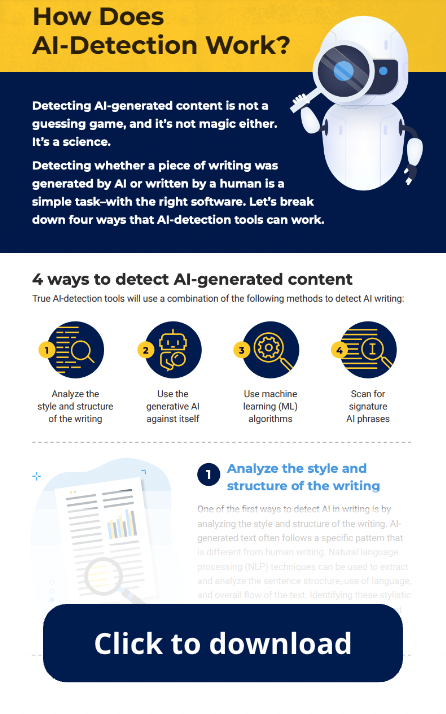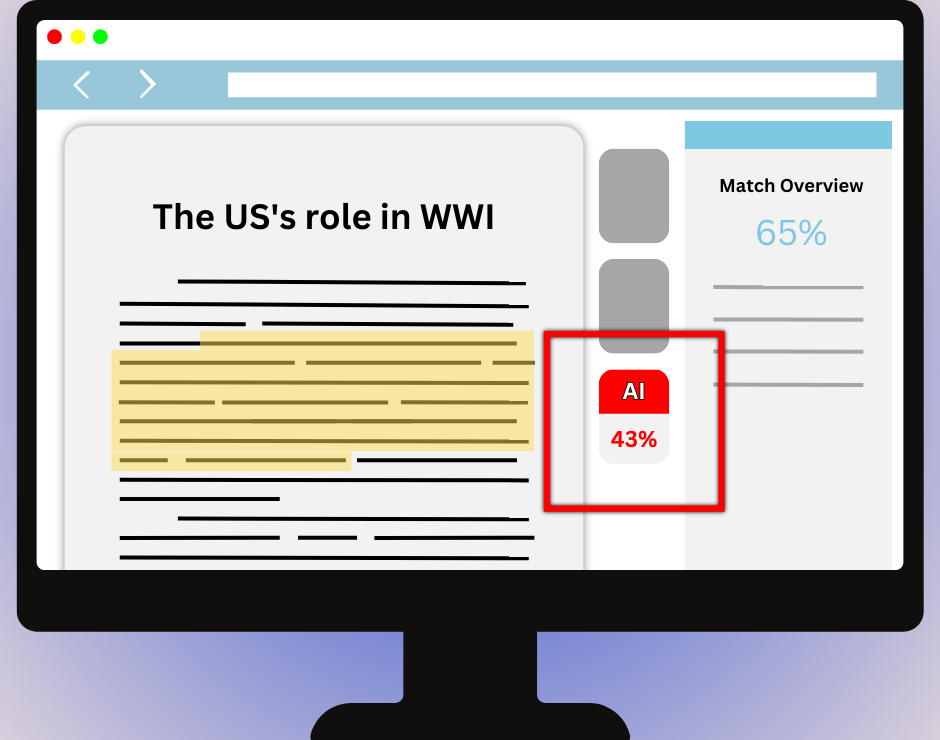AI Detector: Revolutionizing the Way We Identify AI in Text and Media
AI Detector: Revolutionizing the Way We Identify AI in Text and Media
Blog Article
Comprehending the Importance of an Ai Detector in Today's Digital Landscape
As fabricated intelligence remains to permeate various elements of content development, distinguishing in between human-generated and machine-generated product has actually ended up being significantly complex. This advancing landscape presents considerable challenges connected to credibility and trustworthiness, requiring the growth of AI detection tools. These tools not only aid in recognizing AI-produced web content but likewise promote the integrity of info circulation. Understanding their function ends up being important as we browse a future where the credibility of media is under continuous examination. What effects might this have for creators and consumers alike?
The Surge of AI Material

The surge of AI-generated material has significant implications for numerous markets, including advertising and marketing, journalism, and enjoyment - ai detector. Organizations are increasingly making use of these technologies to boost efficiency, individualize material, and involve audiences better. The capacity to evaluate substantial datasets enables AI systems to customize content to satisfy specific user choices, providing a much more personalized experience
Nevertheless, the spreading of AI content likewise increases important considerations for web content creators and consumers alike. As AI comes to be more integrated right into material manufacturing workflows, recognizing the nuances of AI-generated material is crucial for maintaining top quality and importance in a swiftly advancing digital atmosphere. Welcoming this technical advancement while staying cautious about its implications is essential for stakeholders in the electronic media landscape.
Obstacles of Credibility
The appearance of AI-generated content has introduced considerable difficulties relating to credibility in electronic media. As algorithms end up being a lot more sophisticated, comparing human-created and machine-generated web content becomes progressively challenging. This blurring of lines elevates concerns about the trustworthiness of info and the potential for false information to multiply.
One of the key challenges is the erosion of depend on among customers. With AI with the ability of generating practical message, pictures, and videos, individuals might locate it testing to determine genuine sources from misleading ones. This hesitation can result in a broader skepticism of all electronic material, complicating initiatives to determine credible info.
In addition, the implications for copyright are substantial. As AI devices produce content based upon existing works, questions relating to ownership and creativity develop. Content creators might struggle to shield their job from uncredited AI recreations, undermining their civil liberties and incomes.
Lastly, the possibility for malicious uses AI-generated content, such as deepfakes and computerized propaganda, postures major moral and societal threats. These challenges highlight the urgent requirement for structures that support credibility in the digital landscape, making sure that information stays reliable and credible.
Duty of AI Detectors
Attending to the challenges of authenticity in digital media needs cutting-edge remedies, and AI detectors have emerged as a vital device in this effort. These technologies are developed to examine and recognize material created by expert system, thereby helping with the discernment in between human-created and machine-generated products. The duty of AI detectors expands past mere identification; they also contribute to maintaining the integrity of information consumed by the public.
AI detectors utilize sophisticated algorithms to scrutinize various elements of electronic web content, consisting of etymological patterns, architectural anomalies, and particular markers that indicate automation. Their application spans numerous sectors, consisting of journalism, education and learning, and social media sites, where the existence of AI-generated material can result in misinformation and disintegration of trust fund.

Advantages of Using AI Detectors
Making certain authenticity in electronic content symbolizes the fundamental requirement for trust in info resources, and AI detectors function as an effective ally in this pursuit. By determining AI-generated web content, these tools assist keep the stability of details, thereby securing customers from misinformation and boosting overall content high quality.
Among the primary benefits of utilizing AI detectors is their capacity to improve material confirmation processes, substantially lowering the time and effort needed to analyze the authenticity of digital materials. This effectiveness permits material creators, teachers, and services to concentrate on generating premium and trustworthy info, instead of investing too much sources on fact-checking.
Moreover, AI detectors foster liability amongst material creators. The knowledge that AI-generated content can be identified encourages transparency and ethical practices in content production. This, in turn, adds to a more enlightened electronic area, as customers can with confidence involve with confirmed info.
Future of Material Verification
As the landscape of digital special info content continues to evolve, the future of web content confirmation challenges both offers and opportunities for keeping credibility. As AI innovations breakthrough, so as well do the approaches for producing and sharing false information (ai detector). This arms race between content makers and verification tools demands the growth of much more advanced AI detectors capable of discerning authentic content from adjusted or fabricated material

Additionally, the increase of decentralized innovations, such as blockchain, holds pledge for confirming material provenance, guaranteeing that users can map the beginnings of the information they eat. Inevitably, the future of content confirmation will certainly rest on our capability to introduce in the face of evolving risks, fostering a digital environment where authenticity is recognized and supported as a basic concept.
Final Thought
In verdict, the proliferation of AI-generated web content demands robust devices for authenticity verification. The future of content verification pivots on the effectiveness of AI detectors in keeping credibility throughout various media systems.
AI next page material production devices, such as all-natural language handling versions and generative adversarial networks, allow people and companies to generate premium content at unprecedented speeds and lower prices.
Nevertheless, the proliferation of AI web content likewise increases vital factors to consider for web content developers and consumers alike. As the refinement of AI-generated material proceeds to evolve, the function of AI detectors ends up being significantly important in safeguarding authenticity and advertising transparency in electronic communication. The understanding that AI-generated web content can be determined urges openness and moral methods in web content manufacturing.As the landscape of digital web content proceeds to evolve, the future of content verification challenges both provides and chances for preserving credibility.
Report this page